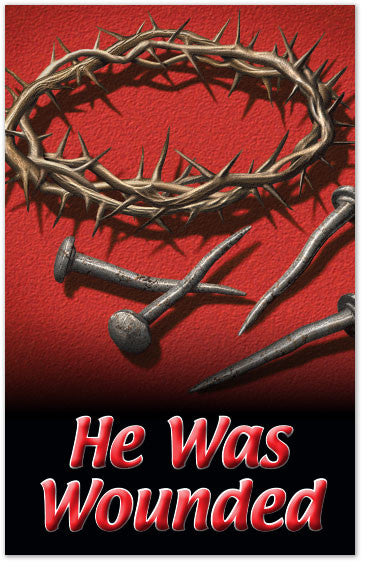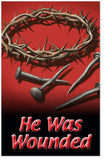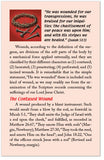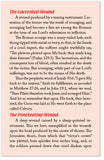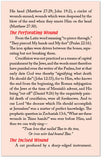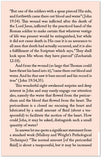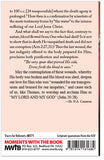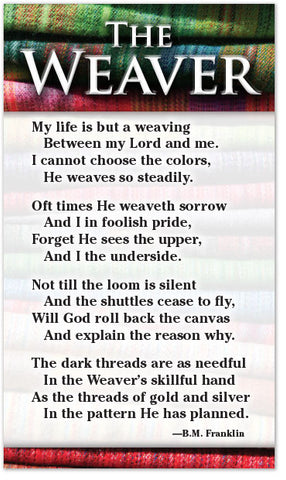He Was Wounded
Folded Tract For Believers
- Estimated shipping date: Tuesday, May 6 (Click for more details)
- SKU:
- Format: Folded Tract For Believers
- Paper: Gloss Text
- Size: 3.5" x 5.5"
- Pages: 6
- Imprinting: Available with 5 lines of custom text
- Version: KJV
Show all item details
The full text of this tract for believers is shown below in the KJV version.
"He was wounded for our transgressions, He was bruised for our iniquities: the chastisement of our peace was upon Him; and with His stripes we are healed" (Isaiah 53:5).
Wounds, according to the definition of the surgeon, are divisions of the soft parts of the body by a mechanical force applied externally, and they are classified by their different characters as (1) contused; (2) lacerated; (3) penetrating; (4) perforated; and (5) incised wounds. It is remarkable that in the simple statement, "He was wounded" there is included each kind of wound, as we may readily see from the examination of the Scripture records concerning the sufferings of our Lord Jesus Christ.
(1) The Contused Wound. A wound produced by a blunt instrument. Such would result from a blow by the rod, as foretold in Micah 5:1, "They shall smite the Judge of Israel with a rod upon the cheek," and fulfilled, as recorded in Matthew 26:67, "They smote Him with rods" (Margin, Newberry); Matthew 27:30, "They took the reed, and smote Him on the head"; and John 18:22, "One of the officers struck Jesus with a rod" (Revised and Newberry, margin).
(2) The Lacerated Wound. A wound produced by a tearing instrument. Laceration of the tissues was the result of scourging, and scourging had become a fine art among the Romans at the time of our Lord's submission to infliction.
The Roman scourge was a many-tailed lash, each thong tipped with metal or ivory, so that, in the hands of a cruel expert, the sufferer might truthfully say, "The plowers plowed upon My back: they made long their furrows" (Psalm 129:3). The torture, the laceration, and the consequent loss of blood, often resulted in the death of the victim, but scourging, while part of our Lord's sufferings, was not to be the means of His death.
Thus the prophetic word of Isaiah 50:6, "I gave My back to the smiters," finds its fulfillment, as recorded in Matthew 27:26, and in John 19:1, where we read, "Then Pilate therefore took Jesus, and scourged Him." And let us remember that upon His back, thus lacerated, the Cross was laid as He went forth to the place called Calvary.
(3) The Penetrating Wound. A deep wound caused by a sharp-pointed instrument. This we have exemplified in the wounds upon the head produced by the crown of thorns. The Jerusalem thorn, from which that "victor's crown" was platted, bore spicules four inches long, and, as the soldiers pressed down that cruel diadem upon His head (Matthew 27:29; John 19:2), a circlet of wounds ensued, wounds which were deepened by the blow of the reed when they smote Him on the head (Matthew 27:30).
(4) The Perforating Wound. From the Latin word meaning "to pierce through." "They pierced My hands and My feet" (Psalm 22:16). The iron spikes were driven between the bones, separating but not breaking these.
Crucifixion was not practiced as a means of capital punishment by the Jews, and the words must therefore have puzzled even the writer of the Psalms, but at that early date God was thereby "signifying what death He should die" (John 12:33), for to Him, who knows the end from the beginning, the Roman subjugation of the Jews at the time of Messiah's advent, and His being "cut off" (Daniel 9:26) by the exquisitely painful death of crucifixion, were all foreknown. And to our Lord "the decease which He should accomplish at Jerusalem" was a matter of perfect knowledge. The prophetic question in Zechariah 13:6, "What are these wounds in Thine hands?" was ever before Him, and thus we can truly sing—
"'Twas love that nailed Thee to the tree,
Or iron ne'er had bound Thee."
(5) The Incised Wound. A cut produced by a sharp-edged instrument. "But one of the soldiers with a spear pierced His side, and forthwith came there out blood and water" (John 19:34). This wound was inflicted after the death of the Lord Jesus, inflicted by the practiced hand of the Roman soldier to make certain that whatever vestige of life was present would be extinguished, but while it did not cause death in His case it is an assurance to all men that death had actually occurred, and it is also a fulfillment of the Scripture which says, "They shall look upon Me whom they have pierced" (Zechariah 12:10).
And from the wound (so large that Thomas could have thrust his hand into it), "came there out blood and water. And he that saw it bare record and his record is true" (John 19:34,35).
This wonderful sight awakened surprise and deep interest in John and may surely engage our attention also, namely the water that flowed from the pericardium and the blood that flowed from the heart. The pericardium is a closed sac encasing the heart and lubricated by a small amount of fluid (about a teaspoonful) to facilitate the motion of the heart. How could John, it may be asked, distinguish such a small quantity of water?
In answer let me quote a significant statement from a standard work (Mallory and Wright's Pathological Technique): "The normal amount [of the pericardial fluid] is about a teaspoonful, but it may be increased to 100 c.c. [24 teaspoonfuls] where the death agony is prolonged." Here then is a confirmation by scientists of the mute testimony borne by "the water" to the intense suffering of our Lord Jesus Christ.
And what shall we say to the fact that, contrary to nature, blood flowed from One who had died? Is it not to show that in death He vanquished death and did not see corruption (Acts 2:27,31)? Thus the last wound, the last indignity offered to the body prepared for Him, proclaims both purification and redemption.
"The very spear that pierced His side,
Drew forth the blood to save."
May the contemplation of these wounds, whereby His body was broken and His blood was shed, deepen our love for Him who was "wounded for our transgressions and bruised for our iniquities," and cause each of us, like Thomas, to worship and acclaim Him as "MY LORD AND MY GOD" (John 20:28).
—Dr. H.A. Cameron
Testimonials
“I have had such pleasant experiences spreading the good news of God's great love by giving out the "Somebody Loves You" tracts. I walk up to someone who looks sad and lonely and I say, "Did you know somebody loves you?" Their faces brighten, they get a big smile and all...” more
“I am currently an inmate and was given a tract called "Why Did This Happen To Me?" It has helped me to grow stronger in my faith and I put all of my trust in the Lord now. I have read from this tract to other inmates in our little...” more
“When I leave the house, I always grab a handful of Bible tracts. You never know when God will send somebody your way unless you are prepared. I've been sowing seeds for about 50 years.”
“I love your tracts and believe they are a tremendous witnessing tool! Presently, my favorite tract is "Have a Good Day!" As people say, "Have a good day," I respond by handing them this tract and replying, "You have a good day as well, and here is something for you to...” more
“Oh, how thankful I am for your soul winning ministry and for those who are able to support you. I am happy to report that by the time you receive this letter, all of the gospel "seeds" (tracts) that you sent me will have been planted in the large field...” more
“I wanted to acknowledge and appreciate your wonderful heart of love being extended to us here in Africa. It was so wonderful that you sent us timely messages for hungry souls. They are touching many souls and blessing many. My heart is full of thanksgiving when we receive letters of...” more
“We want to thank you for your supply of tracts that we received. Praise God that here we are allowed freedom of worship. Your literature is being distributed freely to churches and individuals who testify that they are blessed by your publications. It's a blessing to join with you in...” more
“Thank you for the gift you sent to me. It was a blessing. You guys always put the joy and love in everything you do. I will share all the tracts with everyone that crosses my path. Let's continue to plant those seeds of salvation by His grace.”
“What a blessing it is to be a part of your ministry. You make sharing the gospel fun, exciting, and efficient!”
“Because of your tracts, I and many other inmates here have turned our lives to Jesus Christ. I cannot tell you enough how much we appreciate the work that you do and the powerful Gospel resources that you send.”
What Is Imprinting?
If you select “add imprinting”, we will personalize this tract for you. You can use the space provided to add up to 5 lines of text. It’s a perfect way to include contact information for your church, ministry, or business!
→ For more information please visit our imprinting help page.

Imprinting Questions
How much does imprinting cost? The imprinting charge is $5 per pack.
How long does it take? Orders of less than 3,000 copies (per title) take about 2-3 business days for printing. Orders of 3,000 or more copies (per title) usually require 2-3 weeks for printing.

Where does my information go? Every tract has a space reserved on the back page for imprinting. A live preview is shown on your screen as you enter your text.
Can I add a logo or image? Yes, you can upload your own custom logo or image and it will be printed in full color. If your logo doesn't look quite right after uploading it, don't worry: all jobs are carefully reviewed before printing and we will custom-fit everything together for you.
Do I have to enter my imprint over and over? If you're logged in to your account, any imprints you create will be saved so you can re-use them with a single click.
→ For more information please visit our imprinting help page.

